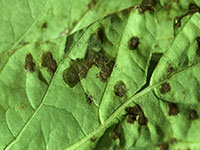By: Anna Stubbendick, FCHP
We hope you’re enjoying the vibrant blooms and lush foliage that summer brings to your garden. But as much as we love those refreshing Florida rains, they can also bring along a host of unwanted visitors – fungi and other plant problems. At Canterbury Farms Nursery & Garden Center, we’ve got your back with some tips and tricks to help you keep your garden looking its best, rain or shine.

Severe powdery mildew infestation on greenhouse-grown squash (Cucurbita spp.). ©UF/IFAS.
Powdery Mildew: The Uninvited Guest
Powdery mildew is a common problem that can rear its fuzzy head during the humid summer months. You might notice a white powdery substance on the leaves of your plants, hindering their growth and vigor. To prevent this, make sure your plants are adequately spaced to allow for proper air circulation. Water at the base of the plants to avoid wetting the foliage, and consider using fungicidal sprays if needed.
Damping Off: A Seedling Nightmare
Seedlings are particularly susceptible to damping off, a fungal disease that causes them to wilt and keel over. To tackle this issue, start with sterilized soil and containers. Ensure proper drainage to avoid waterlogged soil, and water in the morning to allow excess moisture to evaporate during the day. If you notice symptoms, remove the affected seedlings promptly to prevent the spread.
Root Rot: Too Much of a Good Thing
With frequent rain, your plant’s roots might end up sitting in soggy soil for longer than they’d like. This creates the perfect conditions for root rot, a disease that can lead to stunted growth and wilting. Choose well-draining soil and pots with drainage holes. If you suspect root rot, gently remove the plant, trim away the affected roots, let them dry, and replant in fresh soil.
Rust on daylily, upper leaf surface (left) and lower leaf surface (right). Credit: Philip F. Harmon, UF/IFAS
Rust: Not the Antique Charm
Rust appears as rusty or orange spots on the undersides of leaves, stealing the vitality from your plants. Prune infected leaves and improve air circulation around your plants. Water in the morning to give the foliage time to dry out during the day. Fungicides can help control the spread of rust, but prevention is key.
Slugs and Snails: Slimy Intruders
These slimy creatures love the moisture that comes with summer rains. They can munch through your plants’ leaves overnight, leaving behind a trail of destruction. Set up physical barriers like copper tape around vulnerable plants, and consider using natural repellents like diatomaceous earth or beer traps to keep them at bay.
Bacterial Leaf Spot: Unwelcome Spots
Bacterial leaf spot causes dark, water-soaked spots on leaves, eventually leading to leaf drop. Avoid overhead watering and water early in the day. Remove infected leaves and keep your plants dry to prevent further spread. Copper-based fungicides can also help manage this issue.

Bacterial spot on a pepper leaf
Fungicides, Pruning, and Sterilizing Tools: Your Knights in Shining Armor
If fungal issues persist, don’t hesitate to use fungicides following the manufacturer’s instructions. Regular pruning of dead or infected plant parts can significantly reduce the spread of diseases. And don’t forget about your gardening tools! Sterilize your pruners, shears, and other equipment with a solution of one part bleach to nine parts water to prevent the transfer of pathogens between plants.
Why Morning Watering Matters
Watering in the morning is a crucial step in preventing fungal growth. The morning sun helps to quickly dry out excess moisture on leaves and soil. Watering at night, on the other hand, can lead to extended periods of wet foliage, creating an ideal environment for fungi to thrive. By allowing your plants to dry during the day, you’re significantly reducing the risk of diseases taking hold in your garden.

Snail damage. Credit: John L. Capinera, UF/IFAS
Remember, prevention is the best medicine! Keep an eye on your garden, practice good hygiene, and create an environment that’s less favorable for these plant problems. With a little care, your garden will flourish and thrive, even amidst Florida’s summer showers. Happy gardening! 🌿🌧️
For more information, check out these helpful links:

